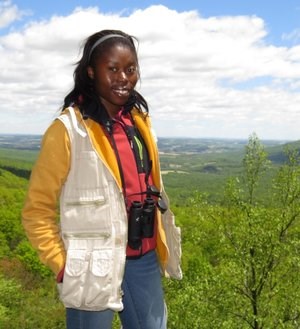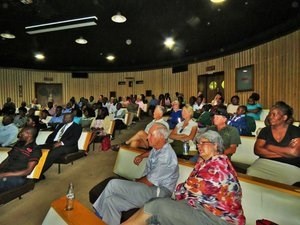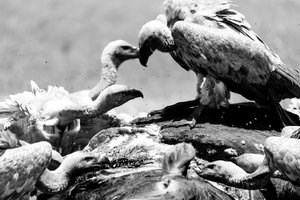Culture in Conservation
Posted on in In the Field by Merlyn Nomusa Nkomo, Former Conservation Science Trainee

During my time at Hawk Mountain Sanctuary, I realized that conservation was a science and has to be regarded so. Before then, I thought it was a love for the environment, turning off lights around the house or turning the tap off when I brushed my teeth. All these acts are important, and if everyone did them they could make a difference.
However, as raptor biologists and conservationists, Dr. Keith Bildstein taught us that conservation is so much more. Conservation is not just an explosion of emotions, because emotions are personal and no one approach is a panacea.
In Africa today, various ‘cultural’ practices have had a negative impact on raptors, particularly vultures. It seems as though culture is playing a part in the demise and extinction of our vultures. This is odd as culture has always been the driving force to safe guarding and conserving wildlife and forests for centuries. Going into this year’s vulture awareness month, I had the question of how culture has evolved so much in southern Africa into a monster that is wiping out vultures in their hundreds.
In my culture, there is no fairy godmothers or tooth fairies, so when my teeth fell as a child, my mother took me outside and taught me a song. The song is to the Yellow-billed Kite Milvus aegyptius, an Intra-African migrant. What you do as a child, if you want your tooth to grow back is to sing the song that goes Mzwazwa! Mzwazwa! Thathi’zinyo lami ungiphe’lakho elihle! This directly translates to: "Yellow-billed Kite! Yellow-billed Kite! Take my tooth and give me your beautiful one!" This is weird since birds have no teeth, and this bird’s tooth is a yellow, curved, and razor sharp bill, which nobody would like growing on them. After singing the song, you are then supposed to throw the tooth over the roof for the Yellow-billed Kite to collect as it flies over your house. This small tradition in my corner of the world makes the bird so important, because children everywhere want the safety of the bird as it brings their adult teeth, and parents everywhere want that moment my mother shared with me so many years ago, passing along the tradition.

My second annual International Vulture Awareness Day seminar at the Natural History Museum of Zimbabwe for this year was themed Vulture Conservation and Culture in Zimbabwe. My intention was for scientists, the general public, and culture experts to talk about vulture conservation issues and what needs to change in Zimbabwe for their protection. I invited the BirdLife Zimbabwe Conservation officer for Special Species Ms. Fadzai Matsvimbo, Zimbabwe Parks and Wildlife Authority (ZimParks) senior ecologist Ms. Lovelater Sebele, and renowned author, historian, and culture expert Mr. Pathisa Nyathi. We had a great turn out of people from all over the city that knew close to nothing about vultures but were intrigued and interested in getting to know about them.
The two speakers from BirdLife Zimbabwe and ZimParks illustrated the current status of vultures in Zimbabwe and what conservation efforts are happening on the ground. BirdLife Zimbabwe works closely with ZimParks in Hwange National Park and has reported on various vulture poisonings around Zimbabwe. In Hwange Park, cyanide poisoning on salt leaks in elephant poaching is the main cause of mass deaths of vultures and many other scavenging animals; however, in other parks like Gonarezhou on the boarder of Zimbabwe and Mozambique, Aldicarb a carbamate insecticide is the most common, along with the harvesting of body parts for muti (traditional medicine).
The major problems faced by organizations like these two are the lack of understanding of the value of vultures and inconsistencies in the litigation process. The judiciary system is failing our vultures, delivered sentences are inconsistent, and often vultures are not included as part of the cases. There is a lack of awareness in game rangers working in the parks, where vulture losses are not properly documented. For these and many other reasons, the two organizations have partnered in educating rangers on identification, data collection on poaching crime scenes, and conservation status.

Our historian and culture expert explained the African philosophy on conservation, and he reminded us that African communities were the best conservationists of natural resources whilst being utilitarian at the same time. African conservation is linked to cosmology and African spirituality, the belief that the earth is our mother and provider—that all matter has life in it, and in order for there to be life there has to be death. This spiritual approach to nature and the world, compared to the scientific, modern approach instills in all Africans a reverence to nature that inspires conservationists.
Due to the philosophy that all matter possesses life, all the parts of an animal carry spiritual characteristics of the animal, and for this reason, vulture bones, beaks, feathers, talons, and even meat are used as muti. Originally, because of the ability of vultures to ‘miraculously’ tell where carcasses are, it was only used by traditional healers for divination as part of their wardrobe. The use of vulture body parts for muti has only recently spiraled out of control due to increased possibilities for foretelling with sports betting, gambling,business successes, and investment results among others.
The biggest take home for all that night, especially for the conservation scientists, was that no external policing is more effective than internal conviction. This means that African children today need to be taught about African philosophy and spirituality to regain that awareness of wildlife. Along with western, scientific, material/physical education, African spirituality also needs to be taught to younger generations as it is being lost in current generations. The scientists were also urged to educate the public of the world view and wildlife understanding through indigenous African knowledge systems and to remain respectful of local people’s beliefs; perceptions are real, just as their consequences are.
In the end, I learned the value of my culture in conservation and how to be a holistic and effective advocate for conservation in my country. Most importantly, I realized the value of one day teaching my children the Yellow-billed Kite song and sharing with them the folklore that made me love and respect nature in my life and my career.
